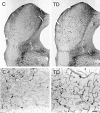Induction of nitric oxide synthase and microglial responses precede selective cell death induced by chronic impairment of oxidative metabolism
- PMID: 9708819
- PMCID: PMC1852979
- DOI: 10.1016/S0002-9440(10)65602-7
Induction of nitric oxide synthase and microglial responses precede selective cell death induced by chronic impairment of oxidative metabolism
Abstract
Abnormal oxidative processes including a reduction in thiamine-dependent enzymes accompany many neurodegenerative diseases. Thiamine deficiency (TD) models the cellular and molecular mechanisms by which chronic oxidative aberrations associated with thiamine-dependent enzyme deficits cause selective neurodegeneration. The mechanisms underlying selective cell death in TD are unknown. In rodent TD, the earliest region-specific pathological change is breakdown of the blood-brain barrier (BBB). The current studies tested whether nitric oxide and microglia are important in the initial events that couple BBB breakdown to selective neuronal loss. Enhanced expression of endothelial nitric oxide synthase and nicotinamide adenine dinucleotide phosphate diaphorase reactivity in microvessels, as well as the presence of numerous inducible nitric oxide synthase-immunoreactive microglia, accompanied the increases in BBB permeability. Nitric oxide synthase induction appears critical to TD pathology, because immunoreactivity for nitrotyrosine, a specific nitration product of peroxynitrite, also increased in axons of susceptible regions. In addition, TD elevated iron and the antioxidant protein ferritin in microvessels and in activated microglia, suggesting that these cells are responding to an oxidative challenge. All of these changes occurred in selectively vulnerable regions, preceding neuronal death. These findings are consistent with the hypothesis that the free radical-mediated BBB alterations permit entry of iron and extraneuronal proteins that set in motion a cascade of inflammatory responses culminating in selective neuronal loss. Thus, the TD model should help elucidate the relationship between oxidative deficits, BBB abnormalities, the inflammatory response, ferritin and iron elevation, and selective neurodegeneration.
Figures







Similar articles
-
Oxidative stress is associated with region-specific neuronal death during thiamine deficiency.J Neuropathol Exp Neurol. 1999 Sep;58(9):946-58. doi: 10.1097/00005072-199909000-00005. J Neuropathol Exp Neurol. 1999. PMID: 10499437
-
Disturbances of the blood-brain barrier without expression of amyloid precursor protein- containing neuritic clusters or neuronal loss during late stages of thiamine deficiency in guinea pigs.Dev Neurosci. 1998;20(4-5):454-61. doi: 10.1159/000017343. Dev Neurosci. 1998. PMID: 9778584
-
Dietary restriction attenuates the neuronal loss, induction of heme oxygenase-1 and blood-brain barrier breakdown induced by impaired oxidative metabolism.Brain Res. 2000 Dec 1;885(1):62-9. doi: 10.1016/s0006-8993(00)02933-4. Brain Res. 2000. PMID: 11121530
-
Vascular endothelium is a site of free radical production and inflammation in areas of neuronal loss in thiamine-deficient brain.Ann N Y Acad Sci. 2000 Apr;903:353-6. doi: 10.1111/j.1749-6632.2000.tb06386.x. Ann N Y Acad Sci. 2000. PMID: 10818525 Review.
-
Selective response of various brain cell types during neurodegeneration induced by mild impairment of oxidative metabolism.Neurochem Int. 2004 Jul-Aug;45(2-3):361-9. doi: 10.1016/j.neuint.2003.09.008. Neurochem Int. 2004. PMID: 15145550 Review.
Cited by
-
Thiamine Deficiency and Neurodegeneration: the Interplay Among Oxidative Stress, Endoplasmic Reticulum Stress, and Autophagy.Mol Neurobiol. 2017 Sep;54(7):5440-5448. doi: 10.1007/s12035-016-0079-9. Epub 2016 Sep 5. Mol Neurobiol. 2017. PMID: 27596507 Free PMC article. Review.
-
Theories of schizophrenia: a genetic-inflammatory-vascular synthesis.BMC Med Genet. 2005 Feb 11;6:7. doi: 10.1186/1471-2350-6-7. BMC Med Genet. 2005. PMID: 15707482 Free PMC article. Review.
-
Protective effects of a compound herbal extract (Tong Xin Luo) on free fatty acid induced endothelial injury: implications of antioxidant system.BMC Complement Altern Med. 2008 Jul 14;8:39. doi: 10.1186/1472-6882-8-39. BMC Complement Altern Med. 2008. PMID: 18625049 Free PMC article.
-
Thiamine deficiency-related brain dysfunction in chronic liver failure.Metab Brain Dis. 2009 Mar;24(1):189-96. doi: 10.1007/s11011-008-9129-y. Epub 2008 Dec 6. Metab Brain Dis. 2009. PMID: 19067139 Review.
-
Benfotiamine treatment activates the Nrf2/ARE pathway and is neuroprotective in a transgenic mouse model of tauopathy.Hum Mol Genet. 2018 Aug 15;27(16):2874-2892. doi: 10.1093/hmg/ddy201. Hum Mol Genet. 2018. PMID: 29860433 Free PMC article.
References
-
- Blass JP, Gibson GE: The role of oxidative abnormalities in the pathophysiology of Alzheimer’s disease. Rev Neurol (Paris) 1991, 147:513. - PubMed
-
- Nixon RA, Cataldo AM: Free radicals, proteolysis and degeneration of neurons in Alzheimer’s disease: how essential is the β-amyloid link? Neurobiol Aging 1994, 15:463-469 - PubMed
-
- Smith MA, Perry G: Free radical damage, iron, and Alzheimer’s disease. J Neurol Sci 1995, 134:92-94 - PubMed
Publication types
MeSH terms
Substances
Grants and funding
LinkOut - more resources
Full Text Sources

